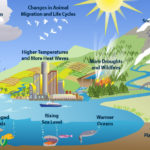
Northeast precipitation, March 2010
My first serious introduction to the topic of climate change came in 2006 with former Vice President Al Gore’s documentary film, An Inconvenient Truth. At the time, I recall that Gore’s warnings were disturbing yet seemed theoretical and distant in an era when emergency management was still inextricably linked with homeland security. In those days, emergency managers’ attention remained largely focused on the post-9/11 problems of radical extremism and the global war on terror. It was only years later that I found myself preparing a report on implications of global climate change for public health emergency preparedness in Rhode Island. What I found was deeply worrying, especially when considering the scientific data in the context of recent experience with Hurricanes Irene and Sandy and Blizzard Nemo.
As emergency managers, it’s hard to deny that we’ve seen some unusual weather patterns in recent years. Rhode Island experienced two “100-year” floods in 2010, Hurricane Irene in 2011, Hurricane Sandy in 2012, “Nemo” in 2013, and significant heat waves in the summers of 2013 and 2014. Meanwhile the winter of 2015 was characterized by a winter-long snow pack such as I’ve not seen before in my 25 years living in Rhode Island, followed by the winter of 2016 which saw very little snowfall at all. These extreme trends are by no means confined to Rhode Island. On a global scale we are witnessing increasing temperatures and rising sea levels accompanied by more intense and frequent severe weather events. Swiss Re, one of the world’s largest reinsurers, says that the annual number of natural disasters occurring around the planet has tripled in the last 40 years. There has already been a massive human toll in terms of shifting threats to human health and well-being, and profound financial implications with the cost of recovery having risen demonstrably over the last 20 years.
Understanding Climate Change
Our planet’s climate is changing because atmospheric greenhouse gases, which have been increasing since the Industrial Revolution, are trapping a growing portion of the sun’s heat in our atmosphere rather than allowing it to radiate back into Space. As heat is the engine that drives weather of all types, the more heat you add to the overall system the more extreme our weather is going to be. Despite lingering political rhetoric, there is no longer any credible scientific debate that our climate is changing and will continue to do so for the foreseeable future. For emergency managers, it should matter not so much why the climate is changing but rather the question must be, “How bad will it be and what must we do to address this new reality?”
Climate can be thought of as the aggregated/overall pattern of weather, and climate change equals alteration of such patterns. A few degrees increase in average temperature globally seems insignificant until one considers the amount of energy that’s being added to our planet to make such a change. This is why even small global temperature variations can lead to big pattern shifts. Because of this effect, climate change impacts not only our baseline weather but also the frequency and magnitude of extreme weather events. As climate change progresses, global weather patterns will continue their overall trend toward being more variable and extreme. In general, this means more intense rainfall events accompanied by more frequent droughts, more powerful and damaging storm systems, redistribution of precipitation among regions of the world, and rising sea levels. These things are not merely theoretical predictions—a few minutes on CNN make it obvious that these things are already happening now.
Climate Change in Lil’ Rhody

Rhode Island’s southern shore took a direct hit from Hurricane Sandy in 2012.
The overall trends associated with global climate change don’t apply equally across the planet. So what future does climate change hold for Rhode Island and our surrounding region? Based on climate change modeling available for our area, including two recent reports completed by TetraTech for the Rhode Island Department of Health, we should expect the following:
- An increasingly warm climate. Already increased by 2 degrees F since the 1970s, Rhode Island’s average annual temperature is expected to rise by another 1.6 degrees in the next twenty years and by 5.7 degrees by the end of the century. By the last decade of the century, the Providence area will experience more than 20 days over 100 degrees every summer (the current average is less than one.)
- Greater humidity. For every1.8 degree F rise in temperature, the air can hold 7 percent more humidity, making the environment feel even hotter and exacerbating the health effects of heat exposure.
- More hurricane landfalls and more powerful storms. Although climate change isn’t expected to increase the overall number of North Atlantic hurricanes, changing ocean and atmospheric currents will shift hurricane tracks northward towards Southern New England. And with more heat in both our atmosphere and our oceans, storms are likely to be more intense with stronger winds and more precipitation. Effects of storm surge will also be much greater as a result of sea level rise and loss of coastal wetlands.
- Rising sea levels and subsiding land. Since 1930, Rhode Island’s sea level has been rising at a rate of 1”per decade. This is roughly twice as fast as it did over the preceding 1,000 years. This current rate is already faster than the global average because Rhode Island’s land mass is also sinking at the same time. Sea level forecasts for Rhode Island vary considerably but the Rhode Island Coastal Resource Management Program has adopted an anticipated sea level increase of 3 to 5 feet as its new basis for planning and policies. Even the most conservative predictions call for upwards of a half a foot relative to current sea levels.
- More frequent and extreme flood events. A trend towards less regular but more intense heavy rain events will intersect with a rising sea level to exacerbate street, river, and coastal flooding in Rhode Island. Already a “100-year” flood is no longer a 100-year event, and neighborhoods once considered safe no longer are. With a 3-foot sea-level rise factored into the equation, a “100-year” flood event for Providence would inundate all coastal regions near Providence Harbor, most of Downtown, South Elmwood, and Washington Park neighborhoods. The effects of a similar event in Newport would be truly catastrophic.
- More frequent summer droughts. Because the ground cannot generally absorb all of the water from these less frequent but heavier rain events, there will be an increased likelihood of short-term summer droughts. Where there is currently a 1-in-20 chance of experiencing a drought in any given summer, such droughts will become almost annual events by century’s end.
- Shorter, warmer, wetter winters. Future winters are likely to be characterized by fewer freezing days, a greater number of freeze/thaw cycles, more sleet/freezing rain events, and generally less snow. Meanwhile, we will see an increase in strength, precipitation, frequency of blizzards and Nor’easter events. And despite overall milder winter conditions, we will still experience days of extreme Arctic cold as we’ve seen in recent winters.
Rhode Island’s Vulnerabilities
All of these climate change effects present significant implications for human health, critical infrastructure, agriculture and fishing, social services, and the state economy. Indeed, some of these are already being felt now. In terms of vulnerabilities, emergency managers should be considering the near- and long-term potential for:
- Damage to state, local, and private infrastructure, particularly bridges and roadways, as lifecycle is shortened and maintenance requirements increased by extreme weather.
- More frequent power outages as a result of extreme weather, infrastructure deterioration, and increased peak demand during hot weather.
- More frequent interruption of communications, including cellular telephone and radio networks resulting from extreme weather events including wind, ice, saltwater intrusion, and storm surge.
- Transportation difficulties resulting from extreme weather that more frequently grounds airline travel, submerges railways, and makes highways impassable.
- Significant farming losses and food chain interruptions as hotter temperatures, ocean acidification, and increased atmospheric carbon dioxide foster invasive species of weeds and pests along with changes to the water cycle and growing season. Hot weather will also see declines in swine, beef, and dairy production while warming oceans threaten survival of key fish species.
Meanwhile, Rhode Island will not be immune to the global effects of migration and population shifts. The greatest impacts of climate change are already being felt in the poorest nations that are unable to adapt, and these effects are combining with regional conflicts to drive massive waves of immigration. This will further increase the financial burden on healthcare, education, and social services resources just as Rhode Island continues to face serious budget shortfalls from growing expenses and shrinking tax revenues. This fiscal strain is being compounded by year after year reductions in federal funding for emergency preparedness, and means that the state will likely continue to have fewer funds available to address the effects of climate change.
Where Do We Go From Here?
As emergency managers, we need to place renewed emphasis on preparation for natural disasters while also recognizing that our services are also likely to be called into play for more routine events such as heat waves, droughts, and infrastructure failures. We need to reexamine the fundamental assumptions on which much of our emergency planning is based, with particular emphasis on the hazard vulnerability assessment process. With climate change accelerating, past weather is no longer a meaningful predictor of future events—or to put it another way, a 100-year storm is no longer a 100-year storm.
In order to leverage our existing preparations and processes, we need to:
- Update existing threat assessments to reflect new climate change predictions, both near- and long-term.
- Review existing plans and procedures, updating assumptions/scenarios to account for climate change.
- Engage other climate change partners to coordinate efforts between emergency preparedness, environmental mitigation, community planning, and related subject areas.
- Educate our colleagues and communities about the need to plan for and prepare for climate change.
- Review current grant guidance to see how climate change can be integrated into existing programs and initiatives.
- Complete a detailed analysis of operational and programmatic implications for our public safety and emergency management agencies.
The bottom line is that climate change is already happening, and it’s happening here in Rhode Island. It’s happening rapidly and it will continue to do so at an ever increasing pace. The effects of climate change are being felt with respect to both extreme events and baseline conditions. In our professional capacity as emergency managers, we can wait and continue to react to these events as they unfold and escalate. Or we can lean forward to understand what’s coming, rethink our past assumptions, and prepare better for what the future holds.



